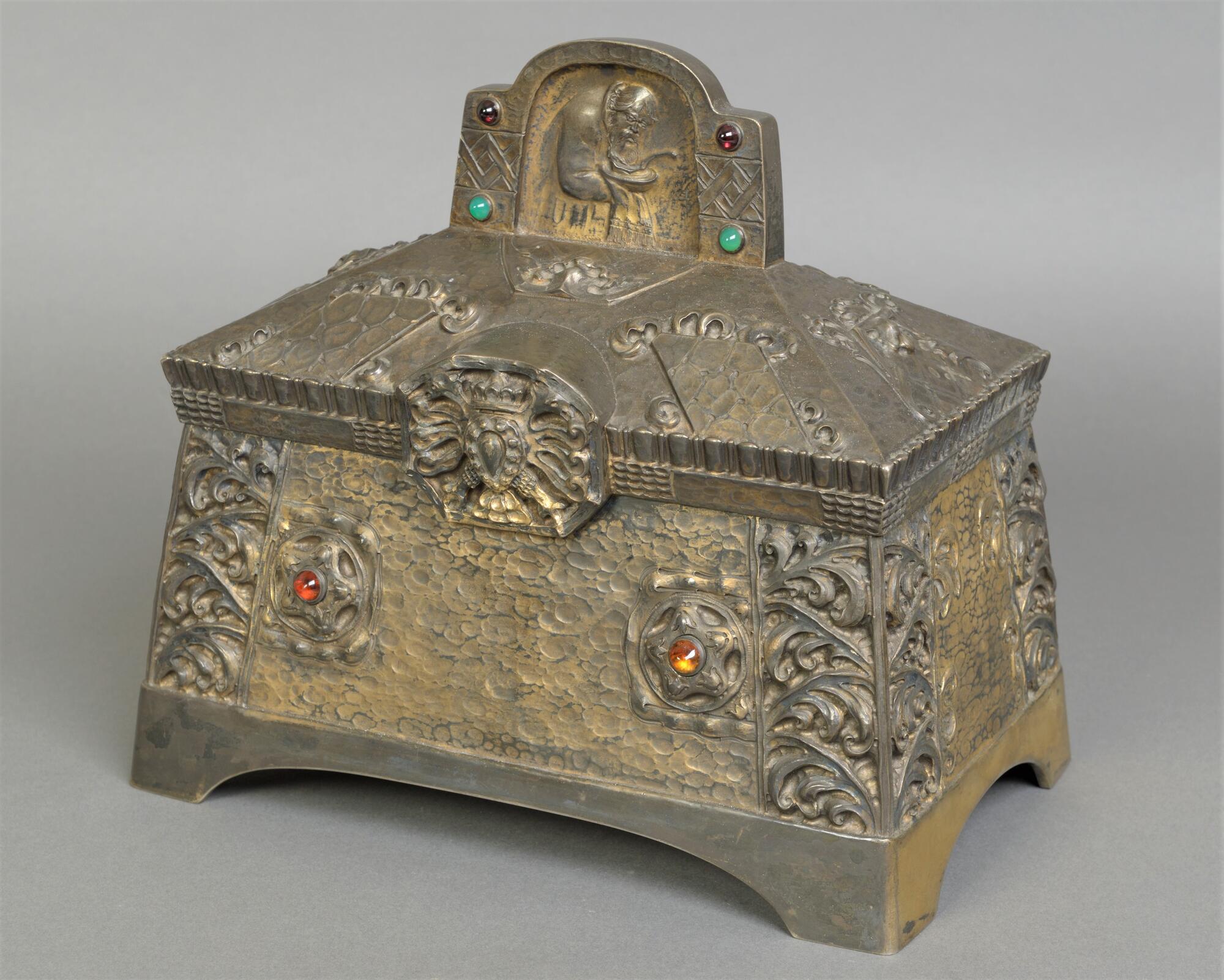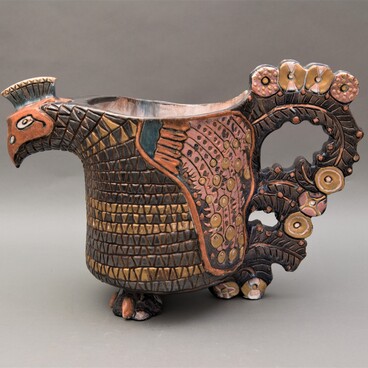In the display case you can see a silver chest with a chased, patinated and gilded surface, decorated with colored semi-precious stones in the form of a cabochon (this is the name of the way a stone is processed, in which it acquires a smooth convex polished surface without edges). The chest is made in a stylized manner based on the ancient Russian chest for storing relics. A double-headed eagle is depicted on the front side of the chest.
The chest itself serves as a sort of decorative podium for the pommel with a relief image of a boyar-cellarer with a ladle. Cellarer was an honorary court position; a boyar in this position was supposed to be present at the table of the Sovereign and bring him drinks, having previously tasted them, he also supervised wine cellars, beekeeping and honey brewing. This image, presumably, is a fragment of the illustration by the artist Viktor Vasnetsov to the ‘Song about Tsar Ivan Vasilyevich, the Young Oprichnik, and the Valorous Merchant Kalashnikov’ by Mikhail Lermontov.
The design of the chest organically combines the artistic stylistics of Russian Art Nouveau, images of folk art and ancient Russian stone architecture. Colored stone cabochons indicate traditional technique for the Russian medieval jewelry art of the Moscow art school.
The second half of the 19th — the beginning of the 20th century is rightfully considered the heyday of Russian gold and silver art, the creation of the domestic jewelry industry. The artistic and technical level of chased, niello and especially enamel items by Russian craftsmen was extremely high. The evolution of the style of artistic metal was largely under the sign of the formation of a national style. Jewelers began to reproduce national motives and imitate handicraft art — for this, special methods of metal processing (casting, embossing, carving) were developed, which made it possible to imitate various materials and techniques in silver.
By the beginning of the 20th century, the Russian style received a new ideological content. The national romantic tradition has ceased to focus on the reproduction of ‘archeologized’ images. Artists turn to literary monuments, epics, folk tales, song folklore, and the traditions of peasant art.
The chest itself serves as a sort of decorative podium for the pommel with a relief image of a boyar-cellarer with a ladle. Cellarer was an honorary court position; a boyar in this position was supposed to be present at the table of the Sovereign and bring him drinks, having previously tasted them, he also supervised wine cellars, beekeeping and honey brewing. This image, presumably, is a fragment of the illustration by the artist Viktor Vasnetsov to the ‘Song about Tsar Ivan Vasilyevich, the Young Oprichnik, and the Valorous Merchant Kalashnikov’ by Mikhail Lermontov.
The design of the chest organically combines the artistic stylistics of Russian Art Nouveau, images of folk art and ancient Russian stone architecture. Colored stone cabochons indicate traditional technique for the Russian medieval jewelry art of the Moscow art school.
The second half of the 19th — the beginning of the 20th century is rightfully considered the heyday of Russian gold and silver art, the creation of the domestic jewelry industry. The artistic and technical level of chased, niello and especially enamel items by Russian craftsmen was extremely high. The evolution of the style of artistic metal was largely under the sign of the formation of a national style. Jewelers began to reproduce national motives and imitate handicraft art — for this, special methods of metal processing (casting, embossing, carving) were developed, which made it possible to imitate various materials and techniques in silver.
By the beginning of the 20th century, the Russian style received a new ideological content. The national romantic tradition has ceased to focus on the reproduction of ‘archeologized’ images. Artists turn to literary monuments, epics, folk tales, song folklore, and the traditions of peasant art.



